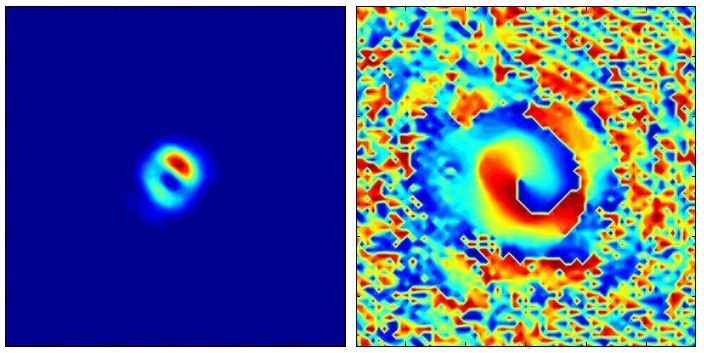New method of creating twisted light may allow fibers to carry more information
September 24, 2013

These
images show the spiral structure of the coherent light emitted from a
beam of electrons accelerated to nearly the speed of light and arranged
into a helix by a simple laser. Left: An intensity map. Note the dark
center where the light cancels itself out, resulting in a cross section
resembling a doughnut. Right: A phase structure map, clearly showing the
helix described by the light. (Credit: Hemsing, et al.)
The method has the potential to generate twisted light in shorter pulses, higher intensities, and a much wider range of wavelengths (including X-rays) than is currently possible.
First described two decades ago, twisted light is attracting attention from researchers in fields as diverse as telecommunications, quantum computing, condensed matter research and astronomy because of one unique property:
Researchers have demonstrated that it can transmit more information through fiber optic cables than the current industry standard.
Creating twisted light with an electron beam
Until now, researchers created twisted light by shooting laser beams through masks or holographic gratings. But a team of accelerator physicists from SLAC and UCLA has shown they can create it with a beam of electrons, in much the same way SLAC’s Linac Coherent Light Source (LCLS) X-ray laser uses electrons to generate pulses of X-ray laser light.

Illustration
of the experiment (not to scale). The unmodulated relativistic electron
beam interacts with a linearly polarized laser in a helical undulator,
which gives the electrons an energy kick that depends on their position
in the focused laser beam. The e-beam then traverses a longitudinally
dispersive chicane that allows the electrons with higher energy to catch
up to those with lower energy (momentum compaction). The result is a
‘helically microbunched’ beam that then radiates light with
OAM at the fundamental frequency in the planar undulator. (Credit: Erik Hemsing et al./Nature Physics)
OAM at the fundamental frequency in the planar undulator. (Credit: Erik Hemsing et al./Nature Physics)
In the case of corkscrewing light, researchers send two pulses — one containing electrons, the other laser light — through an undulator simultaneously.
The combination of laser pulse and undulator imprints an energy pattern on the electrons. As they pass through another grouping of magnets called a chicane, the electrons reposition themselves like race cars on a curve, and hit the next straightaway arranged in the shape of a corkscrew. This “helically microbunched” arrangement of electrons then enters a second undulator that causes them to wiggle and emit spiraling light.
Intense beams of spiraling X-ray light could also open the door to new condensed matter research, said Hemsing.
(¯`*• Global Source and/or more resources at http://goo.gl/zvSV7 │ www.Future-Observatory.blogspot.com and on LinkeIn Group's "Becoming Aware of the Futures" at http://goo.gl/8qKBbK │ @SciCzar │ Point of Contact: www.linkedin.com/in/AndresAgostini
 Washington
Washington